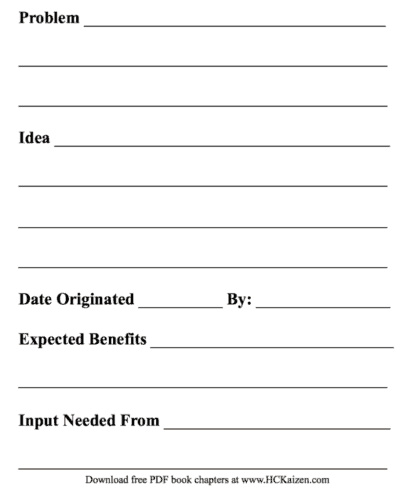When I teach Kaizen methods for continuous improvement, one of the things I recommend is a structured card for capturing problems and ideas for improvement.
Hear Mark read this post (subscribe to the podcast):
The standard card I've used looks like this on the front:

You can see this and other templates here via our Healthcare Kaizen book website.
The templates include editable Powerpoint doc files so you can customize these cards to make them your own, as I encourage people to do.
You can call this a “Kaizen Card.” But, some people don't like using Japanese words….
So you could call this:
- Kaizen Card
- Idea Card
- Improvement Card
- Daily Improvement Card
- Continuous Improvement Card
- ???
What should you call it? I'm not sure it really matters, as long as you choose language that engages your people and resonates with them.
Within this __________ Card structure, what do you call the first field on the card?
I think it's important to not just collect ideas or suggestions. That's too much a classic suggestion box that never works (for a number of reasons). Those suggestion box slips usually just ask for a suggestion. That's jumping to a solution, a bad habit that Lean thinkers try to avoid.
What do we call those ideas on the card in that second space?
- Idea
- Improvement
- Proposed Change
- Solution
- Countermeasure
- Suggestion
- ?????
Before we list an idea or whatever we call it, it's important to ask “What problem are we trying to solve?”
Where a suggestion box system focused on saying yes or no to ideas, the focus in Kaizen is on making things better, if not solving the problem altogether. If we have to say no to an idea, it's the obligation of leaders to help employees come up with other ideas to test.
Although Toyota famously says “No problem is a problem,” some people (not me) have a problem with the word problem.
So what do you call that first field on the card?
- Problem
- Opportunity
- Issue
- Situation
- Current State
- ????
Which label is best? The label the works? The card that works? The Kaizen system that works?
What do you think?
What do you think? Please scroll down (or click) to post a comment. Or please share the post with your thoughts on LinkedIn – and follow me or connect with me there.
Did you like this post? Make sure you don't miss a post or podcast — Subscribe to get notified about posts via email daily or weekly.
Check out my latest book, The Mistakes That Make Us: Cultivating a Culture of Learning and Innovation:










I prefer “Improvement Card”. My basic reasoning is that improvement implies a change for better rather than simply a change (there’s some intent). It also implies a specific gap from current state, not simply dissatisfaction with it. It also implies different thinking than simply “idea”, “issue”, “proposed change” or “situation”.
For the second field, I prefer “Improvement Idea”. It implies a directional thought or hypothesis on how to improve. Suggestion sounds too non-committal, and I find most staff don’t like “countermeasure” (of course I like it though). Solution sounds too final and confident.
As far as the first field goes, I prefer “Problem” but most staff where I work prefer “Opportunity”. I’m starting to knuckle under to the “Opportunity” term. I feel that “Problem” brings some urgency to improvement, but most staff get turned off by the word – too much negative connotation. If it’s to engage staff, then I’m going with “Opportunity”.
I’m generally of the opinion that the specific words “shouldn’t” matter if we’re using them well, but in my experience the words matter a great deal to staff and managers. This has inspired me to adjust our Improvement Cards.
Thanks, Ryan, for the comment.
To me, “problem” and “opportunity” have different meanings. To me, problem means restoring something to a standard or reducing waste. An opportunity is a choice or need to make things better, a new standard. Toyota people called these “caused gaps” and “created gaps,” I believe.
But, what matters is the reaction of people at a client or an organization. If a team has chosen to make the card say “opportunity” and they use the cards and the Kaizen thought process and leadership style, then I won’t quibble over words.
I think the wording should at least match your organizations Improvement terminology, For my organization, we use continuous process improvement, so for question 1, I would say what “Process are you trying to improve?”. Ultimately, it is to continually have personnel linking the overall process improvement system together, with standard terminology. Mix-and-matching terms only confuses people, and when they are confused, they ignore.
Todd — thanks for the comment… good point about consistency being important. One client I’m working with here is calling Kaizen their “Daily Improvement” methodology or program, so “Daily Improvement Card” is a consistent label that makes sense.
A key point, which I see present in this card, is to make a clear separation and distinction between the problem and the idea or proposed solution. All to often we’re tempted to jump to solutions without a proper understanding of the root cause.
Being explicit about the problem that you are trying to solve helps to get the different players involved to think more about root cause and find the right solution, which might not be the initial idea.
Yes, I think that’s a very important point. If we get a suggestion or idea, I’ll ask, “What’s the problem we are trying to solve?” or whatever the appropriate language would be.
Great point also that the initial idea isn’t necessarily the “best” idea. I think I read about some research that said that the first idea is usually NOT the best, hence the benefit of discussing things in a team or even more formally brainstorming seven solutions or ideas, as some advocate for.
Hi Mark,
We call it a ‘Lean Construction Report Card’
the area you are discussing about whether it is a problem or whatever, we call that field ‘report’
Seems to work ok, we’ve had lots of reports both of things that have gone wrong, and suggestions to improve.
The way it is rolled out to teams is important, where there has been a focus, and involvement of the teams on the ground, the cards and process are more successful.
Thanks
Kevin.
Thanks for sharing, Kevin. The key is “what works” and “what resonates with people?”